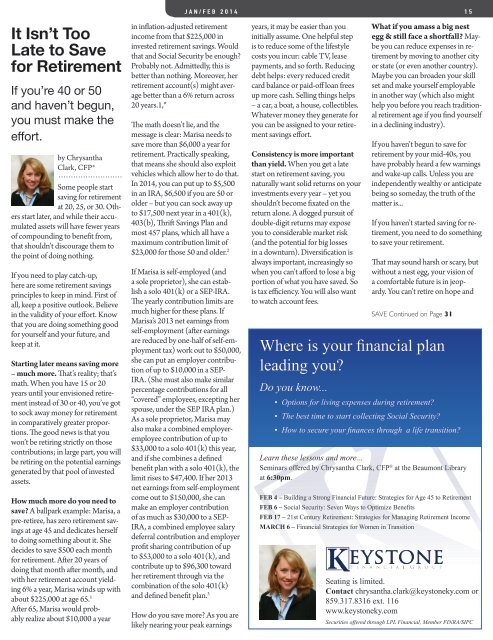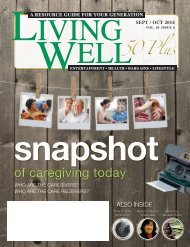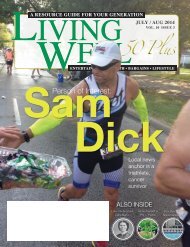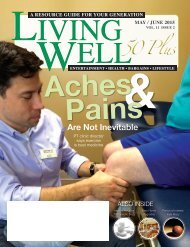Living Well 60+ January-February 2014
Create successful ePaper yourself
Turn your PDF publications into a flip-book with our unique Google optimized e-Paper software.
It Isn’t Too<br />
Late to Save<br />
for Retirement<br />
If you’re 40 or 50<br />
and haven’t begun,<br />
you must make the<br />
effort.<br />
by Chrysantha<br />
Clark, CFP®<br />
Some people start<br />
saving for retirement<br />
at 20, 25, or 30. Others<br />
start later, and while their accumulated<br />
assets will have fewer years<br />
of compounding to benefit from,<br />
that shouldn’t discourage them to<br />
the point of doing nothing.<br />
If you need to play catch-up,<br />
here are some retirement savings<br />
principles to keep in mind. First of<br />
all, keep a positive outlook. Believe<br />
in the validity of your effort. Know<br />
that you are doing something good<br />
for yourself and your future, and<br />
keep at it.<br />
Starting later means saving more<br />
– much more. That’s reality; that’s<br />
math. When you have 15 or 20<br />
years until your envisioned retirement<br />
instead of 30 or 40, you’ve got<br />
to sock away money for retirement<br />
in comparatively greater proportions.<br />
The good news is that you<br />
won’t be retiring strictly on those<br />
contributions; in large part, you will<br />
be retiring on the potential earnings<br />
generated by that pool of invested<br />
assets.<br />
How much more do you need to<br />
save? A ballpark example: Marisa, a<br />
pre-retiree, has zero retirement savings<br />
at age 45 and dedicates herself<br />
to doing something about it. She<br />
decides to save $500 each month<br />
for retirement. After 20 years of<br />
doing that month after month, and<br />
with her retirement account yielding<br />
6% a year, Marisa winds up with<br />
about $225,000 at age 65. 1<br />
After 65, Marisa would probably<br />
realize about $10,000 a year<br />
JAN/FEB 2 0 1 4<br />
in inflation-adjusted retirement<br />
income from that $225,000 in<br />
invested retirement savings. Would<br />
that and Social Security be enough?<br />
Probably not. Admittedly, this is<br />
better than nothing. Moreover, her<br />
retirement account(s) might average<br />
better than a 6% return across<br />
20 years.1,*<br />
The math doesn’t lie, and the<br />
message is clear: Marisa needs to<br />
save more than $6,000 a year for<br />
retirement. Practically speaking,<br />
that means she should also exploit<br />
vehicles which allow her to do that.<br />
In <strong>2014</strong>, you can put up to $5,500<br />
in an IRA, $6,500 if you are 50 or<br />
older – but you can sock away up<br />
to $17,500 next year in a 401(k),<br />
403(b), Thrift Savings Plan and<br />
most 457 plans, which all have a<br />
maximum contribution limit of<br />
$23,000 for those 50 and older. 2<br />
If Marisa is self-employed (and<br />
a sole proprietor), she can establish<br />
a solo 401(k) or a SEP-IRA.<br />
The yearly contribution limits are<br />
much higher for these plans. If<br />
Marisa’s 2013 net earnings from<br />
self-employment (after earnings<br />
are reduced by one-half of self-employment<br />
tax) work out to $50,000,<br />
she can put an employer contribution<br />
of up to $10,000 in a SEP-<br />
IRA. (She must also make similar<br />
percentage contributions for all<br />
“covered” employees, excepting her<br />
spouse, under the SEP IRA plan.)<br />
As a sole proprietor, Marisa may<br />
also make a combined employeremployee<br />
contribution of up to<br />
$33,000 to a solo 401(k) this year,<br />
and if she combines a defined<br />
benefit plan with a solo 401(k), the<br />
limit rises to $47,400. If her 2013<br />
net earnings from self-employment<br />
come out to $150,000, she can<br />
make an employer contribution<br />
of as much as $30,000 to a SEP-<br />
IRA, a combined employee salary<br />
deferral contribution and employer<br />
profit sharing contribution of up<br />
to $53,000 to a solo 401(k), and<br />
contribute up to $96,300 toward<br />
her retirement through via the<br />
combination of the solo 401(k)<br />
and defined benefit plan. 3<br />
How do you save more? As you are<br />
likely nearing your peak earnings<br />
years, it may be easier than you<br />
initially assume. One helpful step<br />
is to reduce some of the lifestyle<br />
costs you incur: cable TV, lease<br />
payments, and so forth. Reducing<br />
debt helps: every reduced credit<br />
card balance or paid-off loan frees<br />
up more cash. Selling things helps<br />
– a car, a boat, a house, collectibles.<br />
Whatever money they generate for<br />
you can be assigned to your retirement<br />
savings effort.<br />
Consistency is more important<br />
than yield. When you get a late<br />
start on retirement saving, you<br />
naturally want solid returns on your<br />
investments every year – yet you<br />
shouldn’t become fixated on the<br />
return alone. A dogged pursuit of<br />
double-digit returns may expose<br />
you to considerable market risk<br />
(and the potential for big losses<br />
in a downturn). Diversification is<br />
always important, increasingly so<br />
when you can’t afford to lose a big<br />
portion of what you have saved. So<br />
is tax efficiency. You will also want<br />
to watch account fees.<br />
Where is your financial plan<br />
leading you?<br />
Do you know...<br />
• Options for living expenses during retirement?<br />
• The best time to start collecting Social Security?<br />
• How to secure your finances through a life transition?<br />
Learn these lessons and more...<br />
Seminars offered by Chrysantha Clark, CFP ® at the Beaumont Library<br />
at 6:30pm.<br />
FEB 4 – Building a Strong Financial Future: Strategies for Age 45 to Retirement<br />
FEB 6 – Social Security: Seven Ways to Optimize Benefits<br />
FEB 17 – 21st Century Retirement: Strategies for Managing Retirement Income<br />
MARCH 6 – Financial Strategies for Women in Transition<br />
1 5<br />
What if you amass a big nest<br />
egg & still face a shortfall? Maybe<br />
you can reduce expenses in retirement<br />
by moving to another city<br />
or state (or even another country).<br />
Maybe you can broaden your skill<br />
set and make yourself employable<br />
in another way (which also might<br />
help you before you reach traditional<br />
retirement age if you find yourself<br />
in a declining industry).<br />
If you haven’t begun to save for<br />
retirement by your mid-40s, you<br />
have probably heard a few warnings<br />
and wake-up calls. Unless you are<br />
independently wealthy or anticipate<br />
being so someday, the truth of the<br />
matter is...<br />
If you haven’t started saving for retirement,<br />
you need to do something<br />
to save your retirement.<br />
That may sound harsh or scary, but<br />
without a nest egg, your vision of<br />
a comfortable future is in jeopardy.<br />
You can’t retire on hope and<br />
SAVE Continued on Page 31<br />
Seating is limited.<br />
Contact chrysantha.clark@keystoneky.com or<br />
859.317.8316 ext. 116<br />
www.keystoneky.com<br />
Securities offered through LPL Financial, Member FINRA/SIPC
















